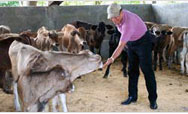You are here » Home » Telling Our Story
Case Study
Establishing municipal parks to preserve cultural heritage and biodiversity
Highlanders Establish Nature Reserves

| |
Photo: TNC/Christa Mehard
|
|
Chuwanimajuyu Municipal Park, Lake Atitlán, Guatemala was established with support from the local government and USAID.
In 2005, four sites in the Atitlán region were consolidated to form the country’s first network of municipal nature reserves covering nearly 3,000 acres.
|
Challenge
Stretching 236 miles from Mexico to El Salvador, Guatemala’s breathtaking Sierra Madre range hosts 37 active volcanic cones. With peaks known as the islands in the sky reaching 11,000 feet, the Atitlán Volcanic chain is a major tourist attraction and sustains an outstanding wealth of biodiversity and sacred Mayan cultural sites. Unfortunately, widespread poverty, high population density, slash and burn agriculture, and uncontrolled tourism threaten the ecological and cultural integrity of the Atitlán region. Deforestation, erosion, habitat fragmentation, and pollution are ruining this majestic terrain.
Initiative
To help preserve Atitlán’s natural resources, in 2001 USAID and The Nature Conservancy launched “Parks in Peril,” a program to establish municipal nature reserves. Using an established conservation planning methodology to set priorities, develop strategies, and measure success, the project identified shade-grown coffee and ecotourism as two sectors where conservation and development could work together to generate funds to reinvest in municipal parks. Working with local organizations and municipalities, Parks in Peril has garnered support for conservation initiatives that generate income and manage natural resources locally.
Results
In 2005, four sites in the Atitlán region were consolidated into the country’s first network of municipal nature reserves. Totaling nearly 3,000 acres, the reserves are implementing management plans that incorporate strategies for park protection, environmental education, wildlife monitoring, and income generation. The reserves are planning to develop infrastructure such as trails, canopy walkways, and signs. In addition to safeguarding rare endemic fauna, the four reserves protect cultural sites sacred to the Kiché Kakchikel and T’zutuhil Mayan Groups. By 2007, the municipal park network will expand to include a total of nine parks where local governments have taken the initiative to manage biodiversity for the benefit of their citizens.
Print-friendly version of this page (511kb - PDF)
Click here for high-res photo
Back to Top ^ | 

